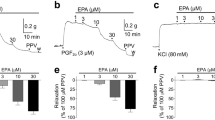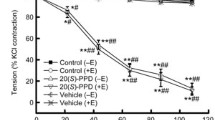Abstract
Purpose
The generation of hyperpolarising vasorelaxant endothelial cytochrome P450 epoxygenase (CYP)—derived metabolites of arachidonic may provide beneficial effects for the treatment of cardiovascular diseases in which the bioavailability of NO is impaired. The cannabinoid methanandamide has vasodilatory properties linked to hyperpolarisation. The aim of the present work was to investigate the vasorelaxant effects of methanandamide in rat aorta, focusing on the role of cytochrome P450 pathway.
Methods
Changes in isometric tension in response to a cumulative concentration-response curve of methanandamide (1 nM–100 μM) were recorded in aortic rings from male Wistar rats. The involvement of cannabinoid receptors, endothelial nitric oxide (NO)-, prostacyclin- and some hyperpolarising-mediated pathways were investigated. The activation of large-conductance Ca2+-activated K+ (BKCa) channels have also been evaluated.
Results
Methanandamide provoked an endothelium-dependent vasorelaxation in rat aorta, reaching a maximal effect (Rmax) of 67% ± 2.6%. This vasorelaxation was clearly inhibited by the combination of CB1 and CB2 cannabinoid antagonists (Rmax: 21.6% ± 1.3%) and by the combination of guanylate cyclase and CYP inhibitors (Rmax: 16.7% ± 1.1%). The blockade induced separately by guanylate cyclase (31.3% ± 2.8%) or CYP (36.3% ± 6.6%) inhibitors on methanandamide vasorelaxation was not significantly modified by either CB1 or CB2 inhibition. BKCa channels inhibition caused a partial and significant inhibition of the methanandamide vasorelaxation (Rmax: 39.9% ± 3.3%).
Conclusions
Methanandamide endothelium-dependent vasorelaxation is mediated by CB1 and CB2 cannabinoid receptors. The NO- and CYP-mediated pathways contribute in a concurrent manner in this vascular effect. Stimulation of both cannabinoid receptor subtypes is indistinctly linked to NO or CYP routes to cause vasorelaxation.







Similar content being viewed by others
References
Roman RJ. P-450 metabolites of arachidonic acid in the control of cardiovascular function. Physiol Rev. 2002;82:31–85.
Spector AA, Norris AW. Action of epoxyeicosatrienoic acids on cellular function. Am J Physiol Cell Physiol. 2007;292:C996–C1012.
Fleming I. Cytochrome P450 epoxygenases as EDHF synthase(s). Pharmacol Res. 2004;49:525–33.
Bauersachs J, Popp R, Hecker M, Sauer E, Fleming I, Busse R. Nitric oxide attenuates the release of endothelium-derived hyperpolarizing factor. Circulation. 1996;94:3341–7.
Hercule HC, Schunck WH, Gross V, et al. Interaction between P450 eicosanoids and nitric oxide in the control of arterial tone in mice. Arterioscler Thromb Vasc Biol. 2009;29:54–60.
Spector AA. Arachidonic acid cytochrome P450 epoxygenase pathway. J Lipid Res. 2009;50:S52–6.
Kunos G, Járai Z, Bátkai S, et al. Endocannabinoids as cardiovascular modulators. Chem Phys Lipids. 2000;108:159–68.
Randall MD, Harris D, Kendall DA, Ralevic V. Cardiovascular effects of cannabinoids. Pharmacol Ther. 2002;95:191–202.
López-Miranda V, Herradón E, Martín MI. Vasorelaxation caused by cannabinoids: mechanisms in different vascular beds. Curr Vasc Pharmacol. 2008;6:335–46.
Dannert MT, Alsasua A, Herradón E, Martín MI, López-Miranda V. Vasorelaxant effect of Win 55, 212-2 in rat aorta: new mechanisms involved. Vascul Pharmacol. 2007;46:16–23.
Herradón E, Martín MI, López-Miranda V. Characterization of the vasorelaxant mechanisms of the endocannabinoid anandamide in rat aorta. Br J Pharmacol. 2007;152:699–708.
Grainger J, Boachie-Ansah G. Anandamide-induced relaxation of sheep coronary arteries: the role of the vascular endothelium, arachidonic acid metabolites and potassium channels. Br J Pharmacol. 2001;134:1003–12.
Watanabe H, Vriens J, Prenen J, Droogmans G, Voets T, Nilius B. Anandamide and arachidonic acid use epoxyeicosatrienoic acids to activate TRPV4 channels. Nature. 2003;424:434–8.
Ho WSV, Randall MD. Endothelium-dependent metabolism by endocannabinoid hydrolases and cyclooxygenases limits vasorelaxation to anandamide and 2-arachidonoylglycerol. Br J Pharmacol. 2007;150:641–51.
Kozłowska H, Baranowska M, Schlicker E, Kozłowski M, Laudañski J, Malinowska B. Virodhamine relaxes the human pulmonary artery through the endothelial cannabinoid receptor and indirectly through a COX product. Br J Pharmacol. 2008;155:1034–42.
Lake KD, Compton DR, Varga K, Martin BR, Kunos G. Cannabinoid-induced hypotension and bradycardia in rats is mediated by CB1-like cannabinoid receptors. J Pharmacol Exp Ther. 1997;281:1030–7.
Malinowska B, Kwolek G, Göthert M. Anandamide and methanandamide induce both vanilloid VR1- and cannabinoid CB1 receptor-mediated changes in heart rate and blood pressure in anaesthetized rats. Naunyn-Schmiedeberg’s Arch Pharmacol. 2001;364:562–9.
Wang Y, Kaminski NE, Wang DH. VR1-mediated depressor effects during high-salt intake: role of anandamide. Hypertension. 2005;46:986–91.
Vanheel B, Van de Voorde J. Regional differences in anandamide- and methanandamide-induced membrane potential changes in rat mesenteric arteries. J Pharmacol Exp Ther. 2001;296:322–8.
Breyne J, Vanheel B. Methanandamide hyperpolarizes gastric arteries by stimulation of TRPV1 receptors on perivascular CGRP containing nerves. J Cardiovasc Pharmacol. 2006;47:303–9.
Sade H, Muraki K, Ohya S, Hatano N, Imaizumi Y. Activation of large-conductance, Ca2+-activated K+ channels by cannabinoids. Am J Physiol Cell Physiol. 2006;290:C77–86.
López-Miranda V, Herradón E, Dannert MT, Alsasua A, Martín MI. Anandamide vehicles: a comparative study. Eur J Pharmacol. 2004;505:151–61.
Zhao J, Majewski H. Endothelial nitric oxide attenuates Na+/Ca2+ exchanger-mediated vasoconstriction in rat aorta. Br J Pharmacol. 2008;154:982–90.
Van der Zypp A, Kang KB, Majewski H. Age-related involvement of the endothelium in b-adrenoceptor-mediated relaxation of rat aorta. Eur J Pharmacol. 2000;397:129–38.
Woodman OL, Malakul W. 3′, 4′-Dihydroxyflavonol prevents diabetes-induced endothelial dysfunction in rat aorta. Life Sci. 2009;85:54–9.
Wagner JA, Varga K, Jarai Z, Kunos G. Mesenteric vasodilation mediated by endothelial anandamide receptors. Hypertension. 1999;33:429–34.
Wagner JA, Jarai Z, Bátkai S, Kunos G. Hemodynamic effects of cannabinoids: coronary and cerebral vasodilation mediated by cannabinoid CB1 receptors. Eur J Pharmacol. 2001;423:203–10.
Ralevic V, Kendall DA, Zygmunt PM, Movahed P, Högestätt ED. Vanilloid receptors on capsaicin-sensitive sensory nerves mediate relaxation to methanandamide in the rat isolated mesenteric arterial bed. Br J Pharmacol. 2000;130:1483–8.
Breyne J, Van de Voorde J, Vanheel B. Characterization of the vasorelaxation to methanandamide in rat gastric arteries. Can J Physiol Pharmacol. 2006;84:1121–32.
Mukhopadhyay S, Chapnick BM, Howlett AC. Anandamide-induced vasorelaxation in rabbit aortic rings has two components: G protein dependent and independent. Am J Physiol Heart Circ Physiol. 2002;282:H2046–54.
Randall MD, Kendall DA, O’Sullivan S. The complexities of the cardiovascular actions of cannabinoids. Br J Pharmacol. 2004;142:20–6.
Mukhopadhyay S, Howlett AC. Chemically distinct ligands promote differential CB1 cannabinoid receptor-Gi protein interactions. Mol Pharmacol. 2005;67:2016–24.
Wagner JA, Abesser M, Karcher J, Laser M, Kunos G. Coronary vasodilator effects of endogenous cannabinoids in vasopressin-preconstricted unpaced rat isolated hearts. J Cardiovasc Pharmacol. 2005;46:348–55.
Járai Z, Wagner JA, Varga K, et al. Cannabinoid-induced mesenteric vasodilation through an endotelial site distinct from CB1 or CB2 receptors. Proc Natl Acad Sci USA. 1999;96:14136–41.
Mendizabal VE, Orliac ML, Adler-Graschinsky E. Long-term inhibition of nitric oxide synthase potentiates effects of anandamide in the rat mesenteric bed. Eur J Pharmacol. 2001;427:251–62.
Högestätt ED, Zygmung PM. Cardiovascular pharmacology of anandamide. Prostaglandins Leukot Essent Fatty Acids. 2002;66:343–51.
Poblete IM, Orliac ML, Briones R, Adler-Graschinsky E, Huidobro-Toro JP. Anandamide elicits an acute release of nitric oxide through endothelial TRPV1 receptor activation in the rat arterial mesenteric bed. J Physiol. 2005;568:539–51.
McCollum L, Howlett AC, Mukhopadhyay S. Anandamide-mediated CB1/CB2 cannabinoid receptor-independent nitric oxide production in rabbit aortic endothelial cells. J Pharmacol Exp Ther. 2007;321:930–7.
Luria A, Weldon SM, Kabcenell AK, Ingraham RH, Matera D, Jiang H, et al. Compensatory mechanism for homeostatic blood pressure regulation in Ephx2 gene-disrupted mice. J Biol Chem. 2007;282:2891–8.
Gollasch M, Wellman GC, Knot HJ, Jaggar JH, Damon DH, Bonev AD, et al. Ontogeny of loval sarcoplasmic reticulum Ca2+ signals in cerebral arteries: Ca2+ sparks as elementary physiological events. Circ Res. 1998;83:1104–14.
Lohn M, Jessner W, Furstenau M, et al. Regulation of calcium sparks and spontaneous transient outward currents by RyR3 in arterial vascular smooth muscle cells. Circ Res. 2001;89:1051–7.
Félétou M. Calcium-activated potassium channels and endothelial dysfunction: therapeutic options? Br J Pharmacol. 2009;156:545–62.
Busse R, Edward G, Félétou M, Fleming I, Vanhoutte PM, Weston AH. EDHF: bringing the concepts together. Trends Pharmacol Sci. 2002;23:374–80.
Félétou M, Vanhoutte PM. Endothelium-derived hyperpolarizing factor: where are we now? Arterioscler Thromb Vasc Biol. 2006;26:1215–25.
Yang Z, Zhang A, Altura BT, Altura BM. Hydrogen peroxide-induced endothelium-dependent relaxation of rat aorta involvement of Ca2+ and other cellular metabolites. Gen Pharmacol. 1999;33:325–36.
Chen JK, Chen J, Imig JD, et al. Identification of novel endogenous cytochrome p450 arachidonate metabolites with high affinity for cannabinoid receptors. J Biol Chem. 2008;283:24514–24.
Acknowledgments
This study was supported by a grants from Ministerio de Educación y Ciencia SAF2006-13391-C03-01 and SAF2009-12422-C02-01, and grants from Comunidad de Madrid S-SAL/0261/2006.
We thank Sanofi Recherche (Montpellier, France) and for generous supply of rimonabant and SR144528.
Conflict of interest
The authors declare that there are no conflicts of interest.
Author information
Authors and Affiliations
Corresponding author
Rights and permissions
About this article
Cite this article
López-Miranda, V., Dannert, M.T., Herradón, E. et al. Cytochrome P450 Pathway Contributes to Methanandamide-induced Vasorelaxation in Rat Aorta. Cardiovasc Drugs Ther 24, 379–389 (2010). https://doi.org/10.1007/s10557-010-6261-9
Published:
Issue Date:
DOI: https://doi.org/10.1007/s10557-010-6261-9




